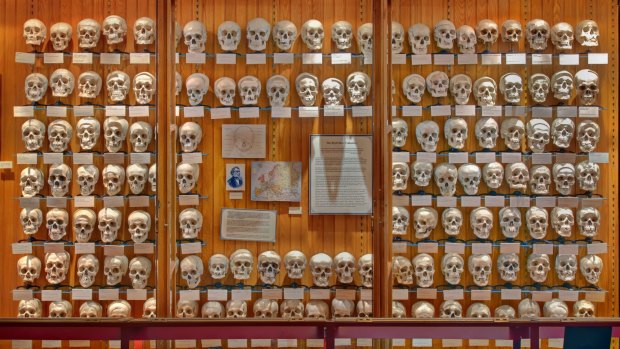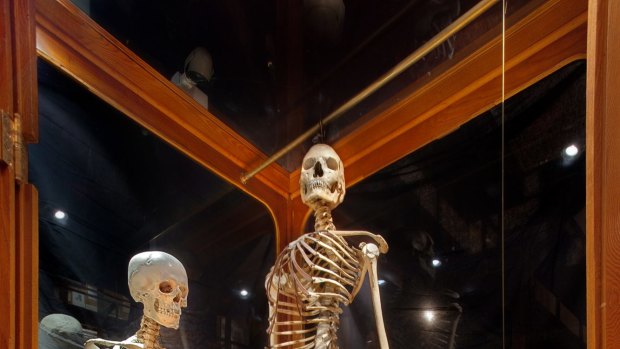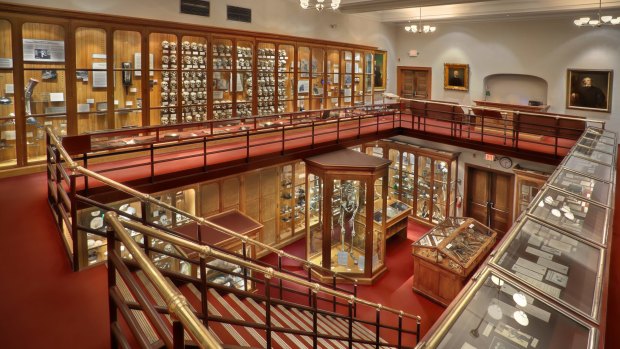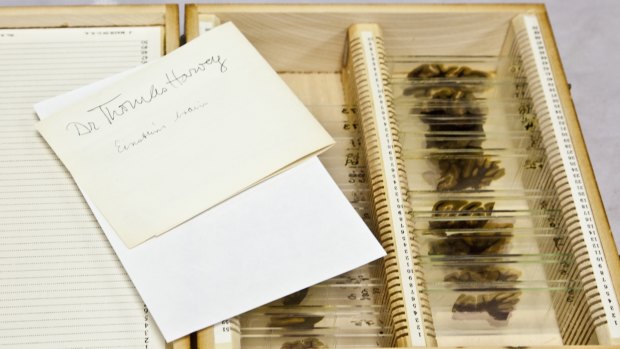This was published 8 years ago
Philadelphia's medical Mutter Museum has an intriguing twist

A cabinet of skulls in the Mütter Museum of The College of Physicians of Philadelphia.
Philadelphia's College of Physicians is a nondescript brick building that you would probably walk past were it not for a sign announcing that the building's contents are "disturbingly informative". What, you can't help but wonder, is that supposed to mean?
In short, it means the Mütter Museum, which was founded in 1858 when Dr Thomas Dent Mütter donated a collection of 1300 anatomic and pathological specimens to the college. Originally, this collection was meant as a teaching aid: it would help doctors better acquaint themselves with the human body and its ailments.
Since then, the collection has grown to 25,000 objects, and opened to the public, though it remains true to its original mandate. "Our mission is the same," Anna Dhody, director of the museum, tells me when I meet her in a basement office. "Our mission in the 150-year-plus history has always been education."

A cabinet showcasing different sized skeletons.
Shrunken heads aside, this place is a far cry from Ripley's Believe It or Not.
Dhody takes me on a tour of the museum, which is spread over two floors, and presented salon-style, with many wooden cabinets and glass panels. I should mention that the Mütter Museum sugar-coats nothing; a visitor should come with an open mind and a strong constitution.
"Certain things definitely elicit audible responses," Dhody says, as we wander past a giant jar filled with flakes of skin, all of them picked off by a person with the mental disorder dermatillomania. As a teaching facility, the museum admits people of all ages; Dhody has seen a seven-year-old ask sensible questions and a 17-year-old pass out from revulsion. To put it mildly, Mütter is a matter of personal taste.

The museum's main gallery.
"If you open any of these drawers," Dhody continues, pointing out safety pins, buttons and nails, "everything you see was removed from somebody's throat."
I could offer long, detailed descriptions of the cabinets surrounding us. I could talk about the conjoined twins, the super-colon, the wax model of an arm riddled with smallpox, the plaster bust of a woman with a salivary gland tumour, even the preserved thorax of John Wilkes Booth, the man who shot Abraham Lincoln. But I'll refrain, because what's most interesting – what makes the Mütter Museum both admirable and worthy for visiting – is how respectfully everything is treated, how soberly and measured.
Labels are kept carefully objective, leaving interpretations to the visitor. It's not about spectacle or sensationalism; it's about reality in all its obtuse and unsettling manifestations. "Knowledge is the most important thing," Dhody says. She wants people to look and marvel at the world around us.

The brain of Albert Einstein on slides.
Two exhibits are particularly effective at provoking this. The first is little more than a series of slides, created by a pathologist named Thomas Harvey. "For decades," a plaque explains, "Harvey kept the brain of one of the world's greatest minds in a glass jar, sometimes in a cider box under a beer cooler, and eventually the brain ended up on the floor of a closet in Kansas. Harvey also dissected the brain into 240 blocks and created 1000 microscopic slides of the brain tissue."
That brain belonged to Albert Einstein, and peering down at slices of the great thinker's brain is to wonder at the power of the brain itself.
The other exhibit, in a room dedicated to "Healing in Civil War Philadelphia," reminds a visitor of how miraculous are the leaps and bounds of modern medicine.
"What was it like to get shot and lose your arm?" asks a sign beside a small black room. I enter my gender, height and skin tone into a touch-screen computer, then enter the room to stand before an oversize mirror. The simulated amputation that follows is relentless and confronting. It also makes me realise another value of museums like this one – empathy, fellow-feeling for others and their suffering.
TRIP NOTES
MORE INFORMATION
discoverphl.com.
GETTING THERE
Several airlines offer flights from Sydney and Melbourne to Philadelphia, including Qantas, via Dallas-Fort Worth. See qantas.com. Philadelphia is conveniently located between New York and Washington DC, making it a good stop on the Amtrak train service. See amtrak.com.
STAYING THERE
The recently refurbished Westin Philadelphia is on Rittenhouse Square, walking distance to many attractions, including the Mütter Museum. Rooms range from about $310 a night. See starwoodhotels.com/westin/philadelphia.
SEE + DO
The Mütter Museum, 19 S 22nd Street, is open daily 10am to 5pm. Entry is $22. See muttermuseum.org.
The writer was a guest of the Philadelphia Convention and Visitors Bureau.
Sign up for the Traveller Deals newsletter
Get exclusive travel deals delivered straight to your inbox. Sign up now.